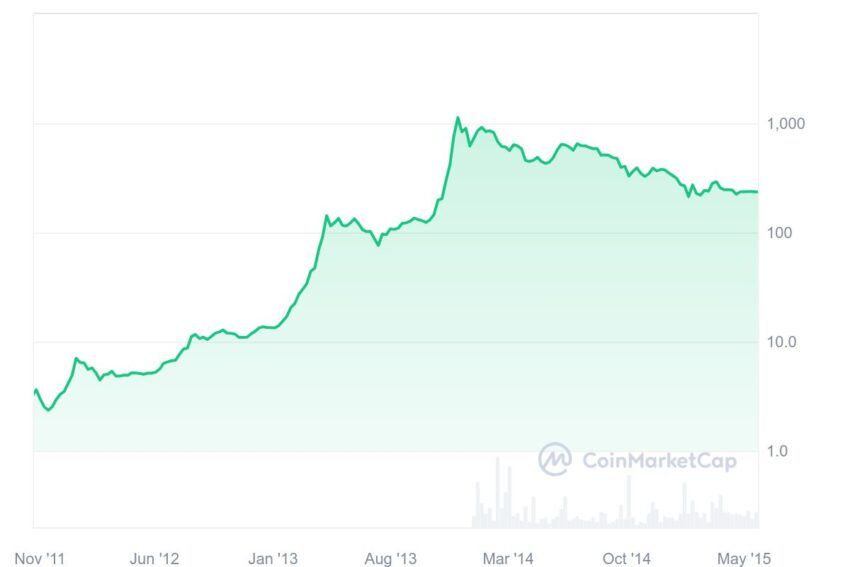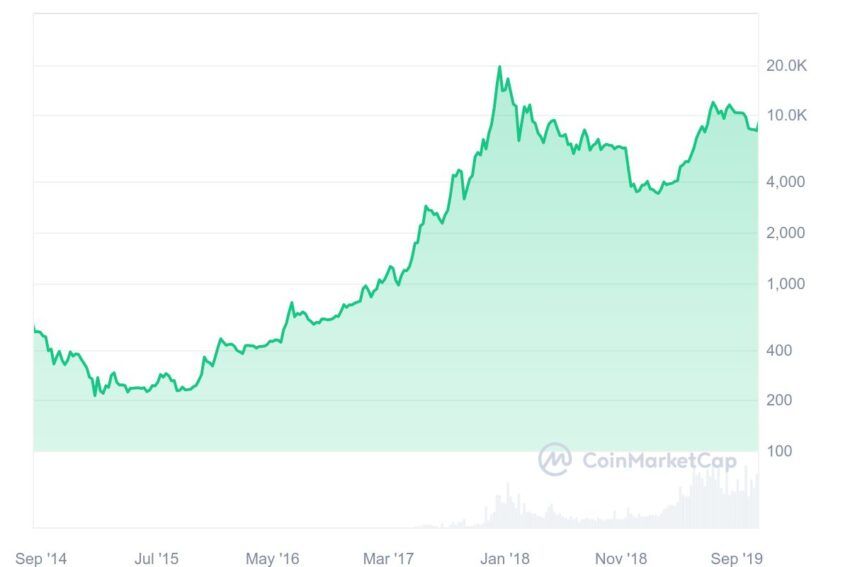The Bitcoin halving event is a significant occurrence in the crypto world. It occurs roughly every four years, reducing the Bitcoin mining block reward by half. The history of Bitcoin halvings shows that the event impacts the supply and demand mechanics and price of Bitcoin. Since Bitcoin was created, there have been three halving events, with the fourth expected to occur in April 2024.
Here’s everything you need to know about Bitcoin’s halving history, including what the halving event is, common misconceptions about it, and what to expect in 2024.
Methodology
In selecting the best platforms for users to buy Bitcoin BeInCrypto considered factors such as ease of use, security features, trading tools, deposit methods, commissions, and additional features offered by the platforms. BeInCrypto’s product teams tested a number of leading exchanges over a period of six months before narrowing down the top options. Here’s why we chose each.
1. Coinbase:
Coinbase’s user-friendly interface makes it accessible to both beginners and experienced traders. The platform’s intuitive design simplifies the buying process, allowing users to purchase Ethereum with ease.
Coinbase also provides users with advanced trading tools and charts, empowering them to make informed decisions. These tools enable users to analyze market trends and execute trades effectively.
Security is paramount when it comes to purchasing Ethereum and any other crypto. Coinbase employs state-of-the-art encryption protocols to safeguard users’ funds and personal information, providing peace of mind to investors.
2. OKX:
OKX stands out for its support of leverage trades, catering to both casual investors and seasoned traders looking to maximize their returns. This feature enhances the platform’s appeal to a wide range of users.
The global platform also offers multiple deposit methods, providing flexibility and convenience to users worldwide.
OKX also notably offers competitive commissions, allowing users to trade Ethereum cost-effectively. Lower fees translate to higher potential returns for investors, making OKX an attractive choice.
3. BDYFi:
With advanced security measures and an easy to use interface, BYDFi suits crypto traders looking to explore the world of spot markets, derivatives, and leverage. The platform supports over 250 cryptos and allows traders to make transactions without KYC registration, perfect for those looking for privacy.
Whether users prioritize simplicity, trading flexibility, or additional features, these platforms cater to diverse needs, providing a comprehensive solution for Bitcoin investors.
To learn more about BeInCrypto’s verification methodologies, follow this link.
- Where to buy Bitcoin before the halving?
- Coinbase
- OKX
- BYDFi
- What is Bitcoin halving?
- How does the four-year cycle of Bitcoin work?
- Common misconceptions about Bitcoin halving
- The history of Bitcoin halvings
- Overview of all Bitcoin halvings
- Bitcoin halving history: Key events
- What to expect in 2024’s Bitcoin halving?
- How many more Bitcoin halvings will there be?
- What happens after the last Bitcoin halving event in 2140?
- How to prepare for a halving event
- How do Bitcoin halvings affect the price of BTC?
- What can the Bitcoin halving history tell us?
- Frequently asked questions
Where to buy Bitcoin before the halving?
The Bitcoin halving countdown is on. Before we dive into the history of Bitcoin halving, here are a few recommended platforms where you can pick up BTC ahead of this seminal event.
Coinbase
• Easy to navigate
• Powerful tools and charts
• Safe and secure
• Regulated
• State-of-art encryption
• Supports leverage trades
• Supports safe and secure transactions
• Multiple deposit methods
• Competitive commissions
• Low fees
BYDFi
• Cross-asset swaps
• Transparent and low fee structure
• One stop easy-to-use trading platform
• Competitive affiliate program
What is Bitcoin halving?
The Bitcoin halving event, also called the Bitcoin block reward halving, is a periodic event in which the block rewards are reduced for Bitcoin miners by half.
The halving event occurs once 210,000 blocks have been mined on the Bitcoin blockchain. Each miner receives a specific amount of Bitcoin once they mine a block on the Bitcoin network. When the Bitcoin halving event occurs, this amount is reduced by half.
The Bitcoin halving is an essential part of the Bitcoin ecosystem, so much so that there is an active countdown each time it is expected to occur. Bitcoin was created with a deflationary mechanism and a fixed supply of 21 million coins. This means there can only ever be 21 million Bitcoins. As of mid-April 2024, over 19 million BTC have been mined. The reward halving was programmed into Bitcoin’s code to occur similarly until all 21 million coins were mined.
It’s expected that there will be 32 Bitcoin halving events. To date, there have been three. The first Bitcoin halving event occurred in November 2012, and the block reward was halved from 50 BTC to 25 BTC. In July 2016, the second halving event took place. The block reward was halved from 25 BTC to 12.5 BTC. The third halving event occurred in May 2020, and the block reward was halved from 12.5 BTC to 6.25 BTC.
The fourth Bitcoin halving event is expected to take place in April 2024. The block reward will be halved from 6.25 BTC to 3.125 BTC. The last halving event is scheduled to take place in 2140, the year when the last BTC will be mined. Once the last halving event occurs, Bitcoin miners will exclusively earn transaction fees. BTC users will pay this as an incentive to continue securing the Bitcoin blockchain and validating transactions.
How does the four-year cycle of Bitcoin work?

As a potential BTC investor, it’s essential to understand how Bitcoin’s four-year cycle works so that you can choose which Bitcoin halving investment strategies to employ and how to invest in BTC.
Halving cycles began in 2009 when Satoshi Nakamoto, the creator of Bitcoin, mined the first block of Bitcoin. This was known as the Genesis block. In the early days after its launch, bitcoin had no monetary value, and people needed to be motivated to participate in mining. After the Genesis block, early miners were rewarded 50 BTC for every successful Bitcoin block they mined.
It’s important to note that although Bitcoin didn’t really have any value at this point, the launch of the first-ever Bitcoin exchange in March 2010 (BitcoinMarket.com) led to an interest in this new digital currency. The Bitcoin price surpassed $1 in 2011 and experienced an upward trend after that.
With the fourth halving event set to occur this month, the process will continue until all 21 million Bitcoins have been mined. The table below summarizes the Bitcoin halving events so far.
| Event | Date | Block number | Block reward | BTC created per day |
| Launch of BTC | January 2009 | 0 | 50 BTC | 7,200 |
| First halving | November 2012 | 210,000 | 25 BTC | 3,600 |
| Second halving | July 2016 | 420,000 | 12.5 BTC | 1,800 |
| Third halving | May 2020 | 630,000 | 6.25 BTC | 900 |
| Fourth halving | ~April 2024 | 840,000 | 3.125 BTC | 450 |
The halving event creates scarcity, which is supposed to impact the value of Bitcoin, causing it to experience a price increase gradually over time. Its occurrence creates an increased demand for bitcoin despite its diminishing rate of new creation, which results in an upward price increase.
Although the Bitcoin halving history has always shown an increase in the price of Bitcoin around 12 to 18 months after each event, investing in Bitcoin shouldn’t be done mindlessly. An up-to-date Bitcoin technical analysis can help you make an informed buying and selling decision while considering other market drivers.
Common misconceptions about Bitcoin halving
Although the Bitcoin halving process is a much-awaited event in the crypto market, it’s also an event that’s shrouded by various misconceptions. Below are some of the more common ones:
- Bitcoin halving results in an instant price increase: The halving history has always impacted the price of Bitcoin. However, these price increases have not always been as immediate as many people tend to think. Instead, the gains tend to be influenced by factors beyond the halving event. In addition, the price increase tends to be gradual, spanning several months.
- Bitcoin halving leads to miner exits: Another big misconception surrounding halving events is that BTC mining will become unprofitable, leading to a mass exit of miners. However, this is not the case. Adjustments in the mining difficulty can help support a miner’s profitability (due to an increasing price) while also maintaining the protocol’s operational stability.
- Bitcoin halving is specific to Bitcoin: Although the Bitcoin blockchain was the first to implement the halving mechanism, the process is not unique to Bitcoin only. Other digital currencies like Litecoin, Bitcoin Cash and Dash have incorporated similar techniques to regulate their coins’ inflation.
- Bitcoin halving is priced beforehand: Many believe the halving event is always already priced in. While the anticipation of the event can affect the price of Bitcoin, the intricacy of external factors and market dynamics indicate that the impact of the halving event cannot be fully recorded in advance.
- Bitcoin halving results in increased transaction fees: Some crypto enthusiasts assume that the halving event leads to increased transaction fees, given that the block rewards diminish. However, this is different, as the available block space and demand influence network fees. Although network fees might surge, the change isn’t entirely dependent on the Bitcoin halving events.
- Bitcoin halving guarantees BTC’s lasting value: While it would be great to see the value of a digital asset like Bitcoin constantly appreciate, halving does not guarantee this. Several factors influence Bitcoin’s value, such as market sentiments, regulatory changes, and technological advancements.
The history of Bitcoin halvings
To date, three Bitcoin halving events have occurred since the digital asset was launched in 2009. Halving events have gradually impacted the price of Bitcoin, a trend that many BTC holders and investors hope will continue.
Every Bitcoin halving event has led to increased media attention, significant price volatility, and speculative anticipation leading up to and after the event. That said, let’s have a look at the overview of all Bitcoin halvings below.
Overview of all Bitcoin halvings
Below is a table of all Bitcoin halving events and the year they are expected to occur. Please note that some figures have been rounded off.
/Related
More Articles| Est. Year | Block number | Block reward | New BTC mined | Total BTC mined |
| 2009 | 0 | 50 | 0 | 0 |
| 2012 | 210,000 | 25 | 10500000 | 10500000 |
| 2016 | 420,000 | 12.5 | 5250000 | 15750000 |
| 2020 | 630,000 | 6.5 | 2625000 | 18375000 |
| 2024 | 840,000 | 3.125 | 1312500 | 19687500 |
| 2028 | 1,050,000 | 1.5625 | 656250 | 20343750 |
| 2032 | 1,260,000 | 0.78125 | 328125 | 20671875 |
| 2036 | 1,470,000 | 0.390625 | 164062.5 | 20835937.5 |
| 2040 | 1,680,000 | 0.1953125 | 82031.25 | 20917968.75 |
| 2044 | 1,890,000 | 0.09765625 | 41015.625 | 20958984.38 |
| 2048 | 2,100,000 | 0.048828125 | 20507.8125 | 20979492.19 |
| 2052 | 2,310,000 | 0.0244140625 | 10253.90625 | 20989746.09 |
| 2056 | 2,520,000 | 0.01220703125 | 5126.953125 | 20994873.05 |
| 2060 | 2,730,000 | 0.006103515625 | 2563.476563 | 20997436.52 |
| 2064 | 2,940,000 | 0.003051757813 | 1281.738281 | 20998718.26 |
| 2068 | 3,150,000 | 0.001525878906 | 640.8691406 | 20999359.13 |
| 2072 | 3,360,000 | 0.0007629394531 | 320.4345703 | 20999679.57 |
| 2076 | 3,570,000 | 0.0003814697265 | 160.2172852 | 20999839.78 |
| 2080 | 3,780,000 | 0.0001907348632 | 80.10864258 | 20999919.89 |
| 2084 | 3,990,000 | 0.0000953674316 | 40.05432129 | 20999959.95 |
| 2088 | 4,200,000 | 0.0000476837158 | 20.02716064 | 20999979.97 |
| 2092 | 4,410,000 | 0.0000238418579 | 10.01358032 | 20999989.99 |
| 2096 | 4,620,000 | 0.00001192092895 | 5.006790161 | 20999994.99 |
| 2100 | 4,830,000 | 0.000005960464475 | 2.503395081 | 20999997.5 |
| 2104 | 5,040,000 | 0.000002980232238 | 1.25169754 | 20999998.75 |
| 2108 | 5,250,000 | 0.0000014901161187.5 | 0.6258487701 | 20999999.37 |
| 2112 | 5,460,000 | 0.0000007450580593.75 | 0.3129243851 | 20999999.69 |
| 2116 | 5,670,000 | 0.0000003725290296.875 | 0.1564621925 | 20999999.84 |
| 2120 | 5,880,000 | 0.0000001862645148.4375 | 0.07823109627 | 20999999.92 |
| 2124 | 6,090,000 | 0.0000000931322574.21875 | 0.03911554813 | 20999999.96 |
| 2128 | 6,300,000 | 0.0000000465661287.109375 | 0.01955777407 | 20999999.98 |
| 2132 | 6,510,000 | 0.0000000232830643.5546875 | 0.009778887033 | 20999999.99 |
| 2136 | 6,720,000 | 0.0000000116415321.7773438 | 0.004889443517 | 21000000 |
| 2140 | 6,930,000 | 0.000000058207660.88867188 | 0.004889443517 | 21000000 |
Bitcoin halving history: Key events
Now that you have an overview of all Bitcoin halving events, past and future, let’s discuss the three that have already occurred.
The first Bitcoin halving: November 2012
The first ever Bitcoin halving event occurred in November 2012, marking an important part of the digital asset’s history. Let’s take a look at the before and aftermath of the first halving event:
Key data:
Date: November 28, 2012
Total supply: Before the first halving event, Bitcoin had a total supply of over 10.5 million coins.
Block rewards: Miners were rewarded 50 BTC for every new Bitcoin block they successfully mined before the halving event.
Price of Bitcoin: Before the event, the price of Bitcoin was at roughly $12.35.
Block number: The halving event occurred after 210,000 blocks of Bitcoin had been mined.
Bitcoin price movements
According to data on CoinMarketCap, before the first halving event, the price of BTC was around ~$12. Following the halving, the price of Bitcoin began to increase gradually. By the end of March 2013, it had surged to nearly $90. This first Bitcoin halving event paved the way for an ensuing bull run.

Key takeaways
- The event reduced the Bitcoin block reward from 50 BTC to 25 BTC. This led to an adjustment to the difficulty of Bitcoin mining, making Bitcoin scarcer as the rate of new BTC entering circulation was reduced.
- The first halving event created much anticipation for subsequent ones, as it impacted the price of BTC, gradually increasing it. So, while the increase wasn’t instant, 2013 achieved the highest price of over $1,000 since its launch in 2009. This event also set the pace for future halving events.
- Since the first halving event, Bitcoin has undergone a significant evolution. This has seen it grow to become the biggest digital currency by market cap and innovate to compete fairly with other cryptocurrencies.
The second Bitcoin halving: July 2016
Four years later, in July 2016, the Bitcoin network underwent its second halving event. Let’s examine what transpired before and after the event.
Key data:
Date: July 9, 2016.
Total supply: Before the second halving event, there were around ~15.7 million coins in circulation.
Block rewards: The block rewards for miners reduced from 25 BTC to 12.5 BTC.
Price of Bitcoin: The Bitcoin price was slightly over $650
Block number: The halving event occurred after 420,000 blocks of Bitcoin had been mined.
Bitcoin price movements
The second halving event in Bitcoin’s halving history set the momentum for significant price fluctuations. In early 2017, the price of Bitcoin grew to roughly $1,000. At the end of 2017, Bitcoin’s price had surged to over $17,000 by December 2017. The notable price surge was a result of various factors, including market sentiment and media coverage, among others.

Key takeaways
- The second halving event reduced the block rewards from 25 BTC to 12.5 BTC, further emphasizing Bitcoin’s scarce nature.
- Bitcoin’s price surge also highlighted the impact of the halving events on Bitcoin’s price, making BTC an attractive store of value for BTC holders.
- In addition to the price increase, the second halving received significant media coverage and sparked conversation on social networks. This contributed to its adoption and continued growth and also shaped the Bitcoin narrative.
The third Bitcoin halving: May 2020
Four years ago, in May 2020, the third halving event occurred. Let’s dive into the before and after effects of the third event.
Key data
Date: May 11, 2020.
Total supply: Bitcoin’s total supply was at roughly 18.35 million coins before the halving event took place.
Block rewards: The block rewards were reduced from 12.5 BTC to 6.25 BTC.
Price of Bitcoin: The price of BTC was slightly over $9,000.
Block number: The halving event occurred after 630,000 blocks of Bitcoin had been mined.
Bitcoin price movements
The third halving event significantly impacted the price of Bitcoin. The price of BTC gradually rose from around $9,000 before the halving event to around $27,000 by December 2020. 2021 was a good year for Bitcoin holders as it ushered in a bull run that saw the price of BTC skyrocket to trade at over $64,000 before it started declining as the crypto winter took hold.

Key takeaways
- The third halving saw the mining reward reduce from 12.5 BTC to 6.25 BTC. In addition, it also helped to push the widespread adoption of Bitcoin among investors, given the diminishing number of coins entering the market.
- The price increases experienced after this halving event established the role of halving events to the price of BTC. Increased interest from investors also made Bitcoin trend with the help of various memes.
- Bitcoin continued to be recognized as an important store of value as it garnered increased attention from the general public, institutional investors, and the media.
- The May 2020 halving event also reinforced Bitcoin’s importance within the wider financial sector. Bitcoin continued to innovate, introducing a wide variety of financial products such as Bitcoin options and futures.
What to expect in 2024’s Bitcoin halving?
The fourth Bitcoin event is expected to occur in April 2024. There has been much anticipation leading up to it, with the price of Bitcoin rallying to reach an all-time high of $73,750 on March 14, 2024.
Besides the known drivers that impact the price of Bitcoin, a key development that impacted the price of Bitcoin in the last few months has been the approval of the Bitcoin ETFs by the U.S. Securities Exchange Commission.
“The halving is the ultimate geek event for bitcoiners, but the 2024 iteration takes it up a notch because reduced supply combined with fresh ETF demand creates an explosive cocktail. What makes this halving unique is bitcoin has already surpassed the last cycle’s high — something it’s never done ahead of the quadrennial event — which makes trying to forecast the length and ferocity of this cycle much trickier.”
Antoni Trenchev, co-founder of Nexo: CNBC
But even as the crypto community gears up for the fourth halving event, what exactly should you expect from the 2024 Bitcoin halving event?
- Potential price volatility: Given Bitcoin’s speculative nature as a digital asset, the period around the halving tends to experience increased price volatility. Ergo, investors need to prepare for potential price swings as the market adjusts to the aftermath of the halved block reward.
- Reduced block rewards: As with any other halving event, the fourth halving event will see the block reward reduce by half, from the current 6.25 BTC to 3.125 BTC.
- Speculation and anticipation: The build-up to any Bitcoin halving event is always rife with anticipation and speculation on how the occurrence will impact the price of Bitcoin. If history is anything to go by, Bitcoin’s price has tended to increase in the lead-up to the event. Still, it’s important to note that various factors beyond the halving event influence the crypto market. Investors can use the cup and handle pattern to verify the potential of a price increase.
- Scarcity and supply: Halving events have always reinforced Bitcoin’s scarcity, attracting many new investors to BTC as “digital gold.” The reduced rate at which new coins enter the market causes an increased demand in BTC. This results in upward pressure on Bitcoin’s price and other digital assets. Nonetheless, this impact is not always instantaneous and tends to unfold over a couple of months and even years after the halving.
- Heightened institutional interest: The period preceding the event has already experienced growing interest from institutional investors keen on finding suitable Bitcoin and crypto mining stocks to invest in. With the halving, it’s anticipated that the interest will expand and witness increased participation from more established corporations, financial institutions, and investment firms that have adopted BTC as an investment instrument.
- Regulatory developments: With the hype surrounding halving events, it’s expected that there will be more calls for regulatory developments as BTC continues to experience widespread adoption.
How many more Bitcoin halvings will there be?
The last Bitcoin halving event is expected to occur in 2140. This is when the last BTC will be mined, and no new BTC will enter the market. In total, there will be 32 halving events. So far, only three halving events have taken place. This means that there are 29 more halving events left.
What happens after the last Bitcoin halving event in 2140?
After the last Bitcoin halving in 2140, there won’t be any more Bitcoin that will be mined. It’s anticipated that this will be the year when the 21,000,000th BTC will be mined.
The Bitcoin protocol will transition to fully relying on transaction fees as the rewards that miners will receive. Given that 2140 is still far off, it’s unclear what the long-term impact will be on Bitcoin’s price, security, and overall role in the global financial system. Much of this remains speculative and will depend on various factors, such as broader economic conditions and technological advancements.
How to prepare for a halving event
There are various ways that investors can prepare for a halving event. Let’s take a look at some of the ways you can prepare for a Bitcoin halving:
- Think long-term: Halving events has always resulted in some price volatility for BTC and other coins in the short term while showing significant growth in the long term. As such, investors need to adopt a long-term investment approach.
- Research: As always, investors need to do their own research before choosing to invest in a digital asset like Bitcoin. In addition, ensure you do your own analysis on broader economic conditions, investor sentiment, and market trends. This will help you have a clear grasp of past and upcoming halving events and historical price movements.
- Manage your risk: Different investors have different risk tolerance and appetite. Before investing in crypto, ensure that you establish clear investment goals. Consider incorporating a risk-averse investment strategy such as the dollar-cost averaging or create a defense trading strategy based on various technical indicators such as the RSI indicator combined with Bollinger Bands, MACD, and others.
- Diversify your portfolio: Investors can diversify their investment portfolio to include various digital assets. This will help to mitigate risks, given that Bitcoin’s price can be quite volatile. Although halving events historically have led to gradual price increases, there are no guarantees, and diversification can aid in protecting your investments.
How do Bitcoin halvings affect the price of BTC?
Bitcoin halvings have historically been associated with bitcoin price increases. The reduced rate with which new BTC creation is achieved helps to create scarcity as the supply of new coins diminishes. This, in turn, tends to drive up the demand for bitcoin and, by extension, its price.
However, a halving event does not always guarantee that it will immediately impact the price of bitcoin. Diversifying your portfolio and deploying various investment strategies can help protect your investments from volatile price swings in the market.
What can the Bitcoin halving history tell us?
This guide to the Bitcoin halving history demonstrates that these events play an important role in the entire crypto market. Although they are subject to much-awaited anticipation and speculation, many savvy investors choose to focus on the coin’s long-term performance.
While the halving events tend to bring with them certain benefits, it’s important to note that as the block reward diminishes, there’s a chance that the changes could impact the protocol security and processing times. With the decreasing supply of new Bitcoin, demand tends to increase, which underscores the scarcity principle of bitcoin as “digital gold” and a store of value. The events have been known to be very pivotal and essential in the ongoing development of Bitcoin and its growth as a digital asset.
Frequently asked questions
Is halving good for Bitcoin?
Is Bitcoin halving every 4 years?
How many Bitcoin halvings are left?
Will BTC go up after halving?
How high will Bitcoin go in 2024?
How much will 1 Bitcoin be worth in 2030?
How high will Bitcoin go in 5 years?
Who owns the most Bitcoin?
Trusted
Disclaimer
In line with the Trust Project guidelines, the educational content on this website is offered in good faith and for general information purposes only. BeInCrypto prioritizes providing high-quality information, taking the time to research and create informative content for readers. While partners may reward the company with commissions for placements in articles, these commissions do not influence the unbiased, honest, and helpful content creation process. Any action taken by the reader based on this information is strictly at their own risk. Please note that our Terms and Conditions, Privacy Policy, and Disclaimers have been updated.









